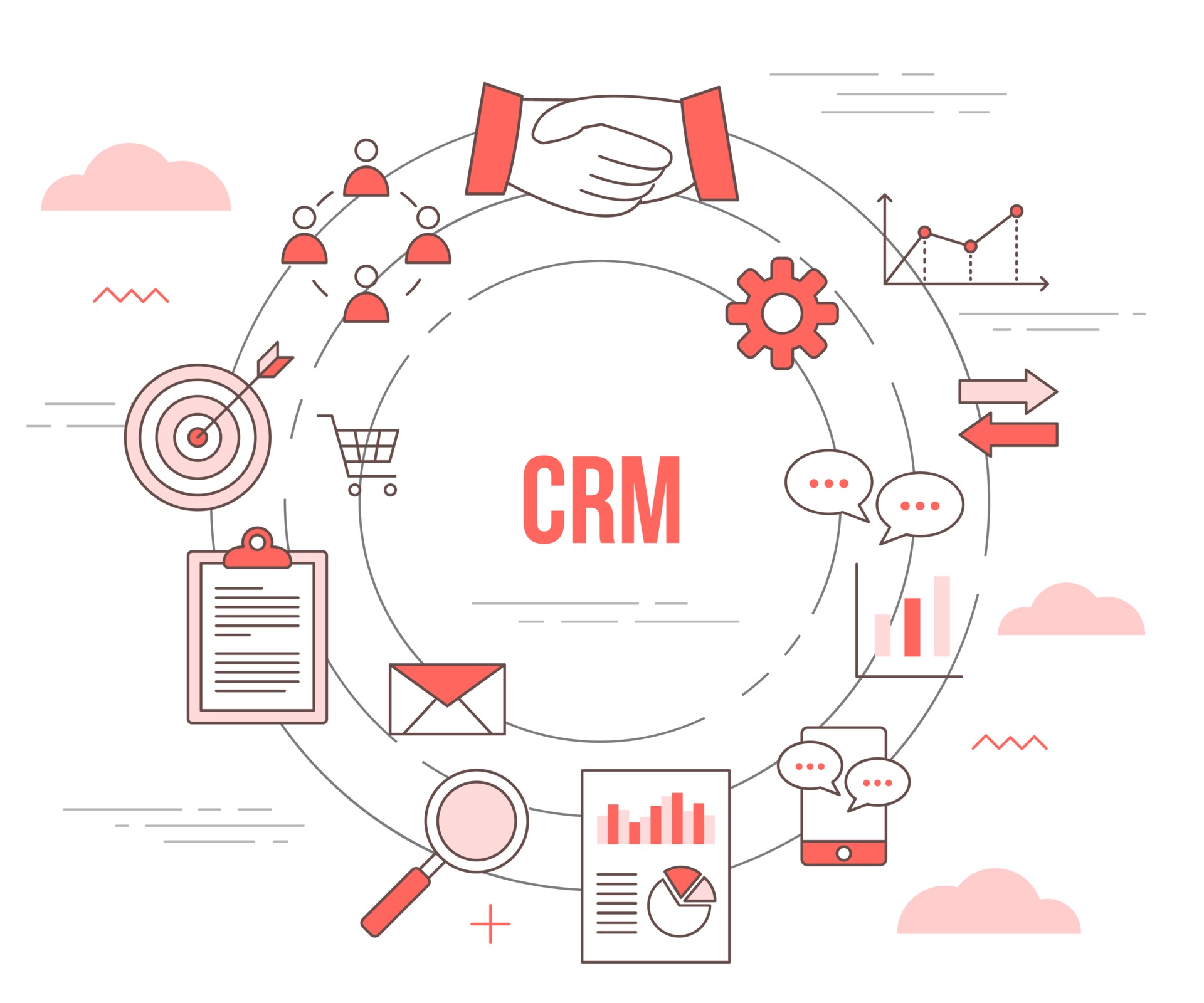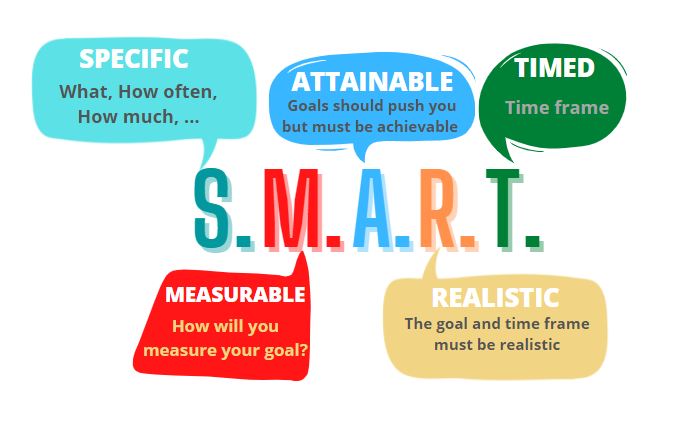Business
All that you need to know about Customer Relationship Management.

Customer satisfaction and loyalty are priorities of successful organizations. The loyal customer is the one who buys the organization’s products periodically and speaks positively about it, which increases the chances of attracting new customers as well as resists the attempts of competing organizations to lure and attract him/her away. This made the relationship with customers a critical matter recently. Nowadays organizations collect and analyze information about that relationship to manage it effectively due to its vital importance to the survival and continuity of the organization.
What is customer relationship management?

Customer Relationship Management (CRM) is a process that enables organizations to manage their interactions with customers, usually using data analysis to examine and analyze large amounts of data.
Why customer relationship management is important?
CRM helps organizations build a relationship with their customers, which in turn creates loyalty. Since customer loyalty and sales are both factors that affect sales, CRM is a strategy that leads to increased profits and maintains a competitive advantage. At its core, a CRM tool creates a simple user interface for a collection of data that helps organizations communicate with customers and address their needs.
- Centralized database:
CRM helps collect data from customers during purchases, after-sales services, or even complaints, which provides information that all departments in the organization can benefit from. Therefore organizations that implement CRM systems benefit from this by creating a unified database to ensure that the inputs for all departments are synchronized which helps to make decisions effectively.
- Automated data entry:
CRM systems depend on the automation of the process of data entry, classification and sorting since the seventies of the last century, which has witnessed great development over time, reaching its peak in the current era with the advancement of communication and information technologies. Which helps to collect and analyze information with almost zero error rates.
- Tracks all sales interactions:
CRM allows the organization to record all the operations that take place with customers, whether purchases, returns, maintenance, after-sales services, or complaints, which gives the organization a detailed reference about its relationship with customers as a whole and its relationship with each customer specifically, as well as measuring their satisfaction with some products. All of this data is of great importance in the decision-making process.
- Reminds time of follow up:
Automation of data recording and review systems, and relying on technological means, allows the organization to follow up on its operations, especially those related to the customer, such as delivery dates, installation, or maintenance. The importance of these systems increases in organizations that deal with a large number of customers and receive thousands or millions of requests per second, which enhances the organization’s ability to control and follow-up, as well as reduce the margin of errors to the least possible.
- Facilitate team/customer communication:
Accurate recording, analysis, and sorting of data in a way that serves the organization’s requirements to get to know its customers are one of the important factors to improve the quality of communication between members of the work team due to the clarity and sufficiency of the data, which facilitates clarity of vision and unification of the work team’s efforts towards improving performance, solving problems or innovation, as well as ease of communication with the customers and understanding their requirements and problems and deal with them efficiently and effectively.
- Enables forecasting:
This process is characterized by the future prediction of customer trends according to the analyzed data previously collected from customers, whether during purchases or continuous follow-up with them, therefore the more data is sufficient, the more accurate the forecasting becomes along with the organization’s ability to identify and categorize leads and manage them.
- Continually grows:
One of the advantages of organizations adopting a CRM strategy is the database that increases with the expansion in dealing with customers or attracting new customers, and it is one of the factors of the organizations’ strengths and competitive advantage in the current era under highly competitive business conditions.
Why do successful organizations adopt CRM strategies?
CRM is a comprehensive marketing strategy for managing all organization’s relationships and interactions with its customers and leads
Therefore many studies have been made to determine the benefits of adopting CRM strategy in organizations which resulted in the following facts:
- 25% increase in revenue.
- 25% : 50% increase in marketing return on investment
- 34% increase in sales productivity.
- 35% increase in customer satisfaction.
- 42% increase in sales forecast accuracy.
- 15% increase in productivity.
- Returning customers are likely to spend 20% : 40% more with organizations that adopt CRM strategy.
- 70% of satisfied customers would recommend the organization to family and friends.
- 41% increase in sales revenue.
- 27% increase in customer retention.
- 23% reduction in marketing costs.
- 75% of managers say that using CRM helps to drive and increase sales.
How to implement CRM strategy?
1- Strategy:
CRM is a comprehensive strategy to increase sales and profits, reduce costs, and improve customer relationships (primarily) by using CRM technology in addition to other marketing strategies and customer care models.
The CRM strategy is based on four main axes:
- Vision:
The vision is the state that the organization seeks and hopes to reach in the future and is characterized by the challenge and motivation to urge all employees to make more effort to achieve. It is important to formulate the vision in line with the organization’s culture, values, and current and expected future capabilities, which requires multiple processes of analyzing data and forecasting the future.
- Mission:
The mission of the organization is the purpose for which it was established and what it is working to achieve through its operations. Therefore, the message must be realistic and expressive of the organization and its goals.
- Goals and plans:
Well-defined goals deliver a clear message inside and outside the organization. While plans provide legitimacy for actions, a source of motivation and inspiration, guidance for commencing tasks, a reference for decisions, and a measurement of performance. Goals and plans are correlated. One cannot achieve a goal without a plan or set a plan without a goal. In many references there are five fundamentals for a well-defined goal namely:

- Specific
- Measurable
- Attainable
- Relevant
- Timed.
It is usually known as SMART or S-M-A-R-T, Therefore In order to apply the SMART goal concept make sure to transform it into numbers. Divide it into smaller objectives. Set a time frame or a deadline. This will help to measure progress and evaluate the situation. Also, it is important that goals are within the organization’s capacity; otherwise, capacity building should the goal.
- Implementation mechanism:
It is a set of programs, procedures, and processes for defining roles along with the powers and responsibilities of each department in the organization in order to achieve the strategy.
2– Customer service:
Customer service is the support that organizations provide to customers both before and after they purchase and use the products or services that help them have a satisfying experience, however other organizations offer self-service support so customers can find their own answers whenever they want.
Basically, there are three important factors of successful customer service which are the three Ps: professionalism, patience, and a people-oriented attitude. Although customer service differs from customer to customer, these guideline offers a rationale for actions and keep the organization on the right track.

- The three Ps of customer service.
3- Social media:
Social CRM or social customer relationship management is the integration of social media channels into customer relationship management (CRM) platforms. CRM platforms are increasingly supporting social media alongside traditional channels so that customers can interact with organizations through their preferred channels. Therefore interaction rates increase as the organization provides more channels for customers to interact with according to their desire through telephone calls, text messages, e-mails, or through pages on social media, therefore 24% of companies witnessed an increase in sales productivity by using CRM mobile apps.
4- Marketing:
Marketing is all aspects of activity that transfer goods and services from the producer to the customer.
Why marketing is important?
Marketing is important to both the producer and the customer.
- The importance of marketing for the producer:
For the producer, successful and effective marketing leads to:
- Distribution of production for all goods and services.
- Achieving profits.
- Enabling the producer to identify the new wants and needs of customers.
- The possibility of increasing the quantity of products, which leads to a reduction in prices.
- The possibility to specialize in the production of one distinct product, through the continuous development of this product.
- The importance of marketing to the customer:
For the customer, successful and effective marketing leads to fulfilling his/her needs of goods and services with the following benefits:
- Fair price.
- Proportionate amount.
- Good quality.
- On the right time.
- In the right place.
Benefits of Marketing:
- Time Utility:
It means that the marketing activity provides all the goods at the right time. That is, storing it at a time when there is no demand for the product and displaying it at the time when the customer needs it.
- Place Utility:
Goods can be provided everywhere through various means of transport (river – land – air-sea – …) to transport the product from the place of production to the place of distribution.
- Possession Utility:
It means the transfer of ownership of the product through purchases and sales from the producer to the customer.
- Form Utility:
Marketing allows production management to identify customers’ desires for goods (and services) in the form and quality that they desire.
The Marketing Mix (8 Ps):
The marketing mix includes a set of policies or marketing activities that integrate and interact with each other in order to produce a successful and effective marketing activity. The mixture includes a number of basic elements, known as (8 Ps):
- Product.
- Price.
- Promotion.
- Place.
- People (personnel).
- Process.
- Physical evidence.
- Performance.

All of these elements represent the marketing policies for organizations in order to prepare their integrated marketing plan. Also, each of these policies includes a set of sub-policies that are integrated with each other to make these policies successful.
- Product:
It means all the goods and services provided by the facility to customers, whether or not the facility aims for profit. This is usually done through practicing a number of sub-marketing functions, the most important of which are:
- Production of a distinct commodity (distinguishing products, that each commodity has a distinct name)
- Packaging design
- Availability of quality standards in the product.
- Providing a product that meets the needs and desires of customers.
- The importance of studying the life cycle of products which usually pass through several stages which are:
- Introduction to the market.
- Growth.
- Saturation.
- Decline.
Understanding these stages helps organizations to address the need to develop their product, develop their packaging, produce a new product, or reconsider the marketing mix as a whole.
- Price:
Pricing policy is intended to determine the appropriate price of a product in accordance with the variables of supply and demand in the market, as well as the ability of customers to purchase that product. The pricing policy includes a number of sub-policies, the most important of which are:
- Determining the basic price of product.
- Price discrepancy in relation to transaction size (quantity discount)
- Installment sale or deferred sale
- Cash sales.
- Determining the policy of discounts (quantity discount – season discount – loyalty discount… etc.)
- Promotion:
It is a set of policies that interact and integrate with each other through the so-called promotion mix, which includes a number of activities, which are:
- Advertising.
- Personal selling.
- Sales promotion.
- Publishing.
- Public relations.
- Place:
It means the distribution channels through which all goods and services are transmitted from the producer to the consumer, which includes the following activities:
- Direct selling (through the producer’s outlets).
- Selling to wholesalers.
- Selling to retailers.
- Authorized agent.
- Broker.
- A combination of the previous activities.
The distribution process is linked to both transportation and storage policies.
- People (Personnel):
The marketing team and all employees responsible for marketing in the organization along with their thoughts and aspirations will have a crucial effect on marketing efforts.
The first step in developing an advertising and marketing plan is to grasp who your target market is. It’s vital to understand your target market and create detailed customer personas.
This will help you communicate immediately to a variety of needs and goals of your goal market with readability and purpose. That’s why innovative content takes a human approach. Respect and empathy are extra than simply keywords. They are the foundation of a sustainable advertising strategy.
It’s integral for all and sundry concerned in marketing products, which include affiliates. Each performs a function in the organizational image and reputation.
- Process:
It includes all procedures necessary to deliver the product from the manufacturer to the customer in addition to after-sale services, such as transportation, maintenance, spare parts, supply, and warranty. In addition to the installment of all the various equipment for the goods that need such installations. Therefore, customers’ satisfaction relies on the efficiency of the process and limiting errors and variations.
- Physical evidence:
The physical evidence elements of the marketing mix refer to the tangible items related to the product or the place where the product is delivered or manufactured. This could include:
- The design of the product along with the interior and exterior design of the building, shop, office…etc.
- The theme of the website.
Design and layout are important as they need to be expressive and representative of the organization’s activity and values. For example, a sportswear retailer needs to ensure that the display, lighting, and internal design present an image of activeness and motivation.
The following processes can be completed to ensure the physical environment gives a positive experience for customers:
- The store should be clean
- The design of the store should reflect the image of the business internally and externally.
- Availability of facilities such as parking, toilet, kids’ area…etc.
The same for websites:
- Easy to navigate
- Products should be displayed with sufficient details.
- Providing information about the company and customer service should be responsive and effective.
- The layout should use colors, text and images that demonstrate the personality and image of the business.
- Performance:
Here, this means the performance of the product that the customer obtains after the purchase process and its conformity with his expectations, whether through a mental image of the organization or the information provided by the seller, whether in person or on the website. In this matter, the after-sales service and feedback are vital to the marketing mix process, which directly affects customer loyalty and the image of the organization.
The 7 Cs as a modern perspective of marketing mix:
Along with the mentioned approaches and strategies, there is a modern approach that emerged in the field of marketing which is called the 7 Cs:
- Clients.
- Convenience.
- Competition.
- Communication.
- Consistency.
- Creative content
- Credibility.

5- Technical support:
Organizations provide technical support services to their customers after the purchase process, whether in cases of installation, maintenance, or repair, as they are vital factors influencing customer satisfaction and loyalty, while the organization’s ability to provide technical support service efficiently and effectively is one of the competitive advantages and strengths that can be relied upon in marketing and promotion operations, as well as expansion and s and entering new markets. Thus the efficiency of technical support relies on the efficiency of data analysis to provide the service in a way that meets or exceeds customers’ expectations.
6- Sales:
Sales are a reflection of the extent of the success of the CRM strategy that aims to increase sales and profits in the first place. Therefore, organizations resort to promotional processes and study customer behavior and trends in order to create a promotional mix that suits their requirements and culture as follows:
The promotion mix:

The promotional mix includes a number of basic elements that aim to stimulate the sales process, the most important of which are:
- Advertising
- Personal Selling
- Sales Activities / Sales Promotions
- Publicity.
- Public Relations
- Advertising:
It is a non-personal means of providing goods or services by a known entity. That is, it is an activity that leads to the dissemination or broadcast of advertising messages to the public to urge them to buy the goods and services that are being advertised.
Conditions that must be met in the advertisement:
- The necessity of defining the audience to whom the advertising message is directed.
- Choosing the technical points that have the greatest impact on the audience of buyers or consumers to whom the advertising message is directed.
- Choosing the best appropriate methods for the audience to whom the advertising messages are directed, by comparing the costs and benefits of these methods.
The difference between information and propaganda:
- Information: means that it disseminates facts, information and news among the public with the aim of spreading ideas among its members and developing awareness among them.
- Propaganda: It is an activity that leads to influencing the ideas and thoughts of the audience in order to make them believe in the contents of that advertisement. Propaganda can be done in more than one way, visible or audible alike information, however the information in propaganda is usually subliminal.
- Personal selling:
It is a personal communication that takes place through sales representatives who meet customers, present products to them, and highlight their advantages with the aim of convincing them and urging them to buy the product.
- Sales activities/promotions:
And that is through non-advertising and direct selling. The most common sales promotion methods are Samples, free gifts, special offers, promotional vouchers, and sale seasons.
- Publicity:
It is intended to raise the demand for the purchase of goods or services by publishing commercial data about them in one of the publications such as newspapers, radio, television, and internet without payment of any fee by the party concerned with publishing these commercial data however, the company may provide the publisher with samples or a free product. For example, social media influencers and reviewers.
- Public Relations:
Public relations has an important role in marketing activity in general and promotion, particularly that it develops relations with other organizations through special offers to their employees along with cooperating with similar and complementary industries.
Bottom line:
Customer relationship management is one of the modern trends in management, which began from in the seventies of the 20th century with the increase of the use of computers in business organizations. Many studies have proven that the use of this strategy has many benefits, whether in increasing profits, customer satisfaction, or the organization’s ability to predict the future trends and needs of customers, providing a competitive advantage and a reliable element of strength to ensure the organization’s survival and continuity in a highly competitive business environment.
Business
Cultural Constraints and Leadership: Navigating the Fine Line

Leadership is a challenge that requires a delicate balance of skills, adaptability, and emotional intelligence. However, these qualities may manifest differently in different cultural contexts, making the task even more complex. In this article, we delve into the realm of cultural constraints and leadership, exploring how leaders can navigate the fine line between different cultural norms and expectations.
Cultures shape our values, beliefs, and behaviors, and these factors play a significant role in leadership dynamics. Understanding cultural constraints is essential for leaders who operate in diverse environments and want to leverage cultural nuances to their advantage.
By embracing cultural intelligence, leaders can foster stronger relationships, build trust, and bridge differences. This requires sensitivity, curiosity, and a willingness to challenge preconceptions. Leaders who can adapt their leadership style to fit cultural contexts will be able to motivate and inspire their team members effectively.
We will explore case studies from different industries and examine how leadership styles have adapted to cultural constraints. By understanding and utilizing these valuable insights, leaders can navigate the fine line between respecting cultural differences and maintaining effectiveness in their leadership roles.
Understanding cultural constraints in different organizational contexts
Cultures shape our values, beliefs, and behaviors, and these factors play a significant role in leadership dynamics. In order to effectively navigate cultural constraints, leaders must first understand the unique characteristics of the cultural context in which they operate.
Different organizational contexts may have varying degrees of formality, hierarchy, and communication styles. For example, in some cultures, such as Japan, there is a strong emphasis on respect for authority and the need to maintain harmony within the group. In contrast, other cultures, such as the United States, may value individualism and direct communication.
Leaders who are aware of these cultural nuances can adapt their leadership style accordingly. They can adjust their communication approach, decision-making processes, and management techniques to ensure that they are aligning with the cultural expectations of their team members.
The impact of cultural constraints on leadership effectiveness
Cultural constraints can have a significant impact on leadership effectiveness. When leaders fail to understand or respect cultural differences, they may inadvertently create barriers that hinder collaboration and productivity within their team.
For example, a leader who is accustomed to a hierarchical leadership style may struggle to engage team members from a culture that values egalitarianism. In this case, the leader’s authoritative approach may be perceived as overbearing or dismissive, leading to a breakdown in trust and cooperation.
On the other hand, leaders who are able to adapt their leadership style to fit cultural constraints can foster a more inclusive and supportive environment. By valuing and incorporating diverse perspectives, leaders can tap into the unique strengths and talents of each team member, resulting in increased innovation and performance.
Strategies for navigating cultural constraints in leadership
Navigating cultural constraints requires a multifaceted approach that combines self-awareness, empathy, and a willingness to learn and adapt. Here are some strategies that leaders can employ to successfully navigate cultural constraints:
1. Educate yourself:
Take the time to learn about the cultural norms, values, and communication styles of the individuals you work with. This will help you better understand their perspectives and adapt your leadership approach accordingly.
2. Build relationships:
Cultivate strong relationships with team members from different cultural backgrounds. This will help you gain insights into their unique experiences and perspectives, and foster a sense of trust and collaboration.
3. Practice active listening:
Actively listen to your team members and demonstrate empathy. This will help you understand their needs, concerns, and aspirations, and enable you to tailor your leadership style to meet their individual and cultural expectations.
4. Be flexible:
Recognize that there is no one-size-fits-all approach to leadership. Be willing to adapt your leadership style to accommodate different cultural constraints and preferences.
5. Continuously learn:
Cultivate a growth mindset and seek out opportunities to learn from different cultural contexts. This can involve attending cultural awareness training programs, reading books and articles on cross-cultural leadership, or engaging in open and honest conversations with individuals from different cultural backgrounds.
By implementing these strategies, leaders can develop the cultural intelligence necessary to navigate cultural constraints and lead effectively in diverse environments.
Developing cultural intelligence for effective leadership
Cultural intelligence refers to an individual’s ability to navigate and adapt to different cultural contexts. It is a key competency for leaders who operate in multicultural environments, as it enables them to bridge differences, build trust, and effectively manage teams from diverse backgrounds.
Developing cultural intelligence begins with self-awareness. Leaders must first understand their own cultural biases, assumptions, and values in order to effectively navigate cultural constraints. This involves reflecting on their own cultural upbringing and experiences, and recognizing how these factors may shape their leadership style and decision-making processes.
Once leaders have a strong sense of self-awareness, they can then focus on developing their cultural knowledge. This involves actively seeking out information about different cultural norms, values, and communication styles. Leaders can engage in cross-cultural training programs, read books and articles on cultural intelligence, and engage in meaningful conversations with individuals from different cultural backgrounds.
In addition to self-awareness and cultural knowledge, leaders must also develop their cultural skills. This involves honing their ability to adapt their leadership style to align with different cultural expectations. Leaders can practice active listening, observe and learn from local leaders in different cultural contexts, and seek feedback from team members to ensure that their leadership approach is effective and inclusive.
By continually developing their cultural intelligence, leaders can navigate cultural constraints with confidence, build strong and diverse teams, and drive organizational success.
Case studies: Successful leaders navigating cultural constraints
Examining case studies of successful leaders who have effectively navigated cultural constraints can provide valuable insights and inspiration for other leaders facing similar challenges. Let’s explore a few examples:
1. Satya Nadella, Microsoft:
Satya Nadella, the CEO of Microsoft, has been praised for his ability to bridge cultural differences and foster collaboration within the organization. When he took over as CEO, he recognized the need to transform Microsoft’s culture to be more inclusive and open to new ideas. Under his leadership, Microsoft has become a more agile and innovative company, with a strong focus on diversity and inclusion.
2. Indra Nooyi, PepsiCo:
Indra Nooyi, the former CEO of PepsiCo, is known for her inclusive leadership style that embraces cultural diversity. She recognized the importance of understanding different cultural perspectives and incorporated them into PepsiCo’s strategies and decision-making processes. As a result, PepsiCo has been able to successfully navigate cultural constraints and expand its global footprint.
3. Carlos Ghosn, Renault-Nissan-Mitsubishi Alliance:
Carlos Ghosn, the former CEO of the Renault-Nissan-Mitsubishi Alliance, is a well-known example of a leader who successfully navigated cultural constraints. He led a multinational organization with diverse cultural backgrounds, and he was able to bridge these differences by fostering a culture of respect, collaboration, and shared goals.
These case studies highlight the importance of cultural intelligence and adaptive leadership in navigating cultural constraints. By understanding and leveraging cultural differences, leaders can create inclusive and high-performing teams.
The role of diversity and inclusion in overcoming cultural constraints
Diversity and inclusion play a crucial role in overcoming cultural constraints and fostering effective leadership. Organizations that prioritize diversity and inclusion are better equipped to navigate cultural differences and leverage the unique perspectives and talents of their team members.
When leaders create an inclusive environment where individuals feel valued and respected, team members are more likely to share their diverse perspectives and ideas. This leads to increased innovation, problem-solving, and creativity within the organization.
Furthermore, diversity and inclusion initiatives can help leaders develop cultural intelligence and bridge cultural differences. By actively seeking out diverse perspectives and experiences, leaders can broaden their understanding of different cultural contexts and adapt their leadership style accordingly.
In order to promote diversity and inclusion, leaders can implement strategies such as:
– Diverse hiring practices:
Actively recruit individuals from different cultural backgrounds and ensure that selection processes are fair and unbiased.
– Inclusive communication:
Foster open and transparent communication channels that encourage all team members to contribute and share their perspectives.
– Training and development programs:
Offer cultural awareness and sensitivity training programs to help leaders and team members develop the skills necessary to navigate cultural constraints.
By prioritizing diversity and inclusion, leaders can create a culture that values and celebrates differences, enabling them to effectively navigate cultural constraints and drive organizational success.
Training and development programs for leaders in multicultural environments
To equip leaders with the skills necessary to navigate cultural constraints, organizations can implement training and development programs that focus on cultural intelligence and adaptive leadership.
These programs can include:
1. Cultural awareness training:
Provide leaders with an understanding of different cultural norms, values, and communication styles. This can involve workshops, seminars, or online modules that help leaders develop a deeper appreciation for cultural diversity.
2. Cross-cultural communication skills:
Offer training on effective cross-cultural communication techniques. This can help leaders navigate linguistic and cultural barriers, and ensure that their messages are understood and appreciated by team members from different cultural backgrounds.
3. Coaching and mentoring:
Pair leaders with mentors or coaches who have experience working in multicultural environments. This can provide leaders with valuable insights and guidance on how to navigate cultural constraints and develop their cultural intelligence.
4. Experiential learning opportunities:
Provide leaders with opportunities to immerse themselves in different cultural contexts. This can involve international assignments, job rotations, or cross-cultural team projects that enable leaders to gain firsthand experience and develop their cultural adaptability.
By investing in training and development programs, organizations can empower leaders to navigate cultural constraints with confidence and drive success in multicultural environments.
Overcoming common challenges in navigating cultural constraints
Navigating cultural constraints is not without its challenges. Leaders may encounter various obstacles along the way, such as:
1. Language barriers:
Communication can be hindered by differences in language proficiency. Leaders must find ways to bridge the language gap, such as using interpreters or providing language training for team members.
2. Preconceived stereotypes:
Leaders must actively challenge preconceived stereotypes and biases to foster an inclusive and respectful environment. This requires ongoing self-reflection and a commitment to learning and growth.
3. Resistance to change:
Cultural constraints may lead to resistance to change, particularly when existing practices and norms are deeply ingrained. Leaders must effectively communicate the benefits and rationale behind proposed changes to gain buy-in from team members.
4. Misinterpretation of signals:
Cultural differences can result in misinterpretation of non-verbal cues and signals. Leaders must be mindful of these differences and seek clarification when needed to avoid misunderstandings.
By acknowledging and addressing these challenges, leaders can develop strategies to overcome them and navigate cultural constraints more effectively.
Conclusion: Embracing cultural constraints for leadership success
In today’s globalized world, cultural constraints are an integral part of leadership dynamics. Leaders who embrace cultural differences and adapt their leadership style accordingly can build stronger relationships, foster trust, and inspire their team members.
Understanding cultural constraints begins with self-awareness and a commitment to continuous learning. Leaders must educate themselves about different cultural norms, values, and communication styles to effectively navigate cultural differences.
By developing cultural intelligence, leaders can bridge cultural constraints, foster diversity and inclusion, and drive success in multicultural environments. Through training and development programs, organizations can equip leaders with the necessary skills to navigate cultural constraints and lead effectively.
By embracing cultural constraints, leaders can navigate the fine line between respecting cultural differences and maintaining effectiveness in their leadership roles. In doing so, they can unlock the full potential of their teams and achieve sustainable success in today’s diverse and interconnected world.
Business
Beyond Barriers: Embracing Cultural Diversity in Leadership
Cultural Diversity in Leadership

In today’s globalized world, cultural diversity is no longer just a buzzword; it is a necessity, especially in leadership roles. As companies expand their operations and reach new markets, leaders who can navigate the complexities of cultural differences are in high demand. Gone are the days when a one-size-fits-all approach to leadership was effective. Instead, organizations are looking for leaders who can embrace diversity and leverage it as a strength.
Embracing cultural diversity in leadership goes beyond just ticking a box for diversity quotas. It requires a genuine understanding and appreciation of different cultures, customs, and perspectives. Leaders who can embrace cultural diversity can create inclusive environments where individuals from different backgrounds feel valued and empowered to contribute their unique perspectives. This ultimately leads to better decision-making, innovation, and overall business performance.
However, embracing cultural diversity in leadership is not without its challenges. It requires a commitment to ongoing learning, unlearning biases, and fostering an open and inclusive culture. It also requires leaders to be adaptable and flexible in their leadership styles to accommodate diverse needs and expectations.
In this article, we will explore the importance of embracing cultural diversity in leadership and provide practical tips for leaders to effectively navigate and leverage this diversity for organizational success.
Understanding Cultural Diversity – Definition and Importance
Cultural diversity refers to the presence of different cultures and cultural groups within a society, organization, or team. It encompasses differences in race, ethnicity, nationality, language, religion, customs, and traditions. Embracing cultural diversity in leadership is not just about token representation or meeting diversity quotas; it involves understanding and appreciating the unique perspectives, experiences, and values that individuals from different cultures bring to the table.
The importance of embracing cultural diversity in leadership cannot be overstated. Firstly, it fosters creativity and innovation. When people with different backgrounds come together, they bring a wide range of ideas, knowledge, and problem-solving approaches. This diversity of thought can lead to breakthroughs and new perspectives that can drive innovation within an organization.
Secondly, embracing cultural diversity in leadership enhances decision-making. When leaders consider different viewpoints and perspectives, they are more likely to make informed and well-rounded decisions. This can help avoid groupthink and promote critical thinking, leading to better outcomes for the organization.
Lastly, embracing cultural diversity in leadership improves employee engagement and retention. When individuals from diverse backgrounds feel valued and included, they are more likely to be engaged and committed to their work. This not only boosts productivity but also reduces turnover, saving organizations time and resources in recruiting and training new employees.
Benefits of Embracing Cultural Diversity in Leadership
Embracing cultural diversity in leadership brings numerous benefits to organizations. Firstly, it enhances problem-solving capabilities. When leaders embrace cultural diversity, they tap into a wealth of diverse perspectives, experiences, and knowledge. This allows them to approach problems and challenges from different angles, leading to more effective and innovative solutions.
Secondly, embracing cultural diversity in leadership fosters creativity and innovation. When individuals from different cultures come together, they bring unique ideas, insights, and approaches to the table. This diversity of thought can spark creativity, leading to the generation of new ideas and the ability to adapt to changing market demands.
Furthermore, embracing cultural diversity in leadership enhances cultural competency. Leaders who are culturally competent can navigate and bridge cultural differences effectively. They can understand and appreciate different customs, traditions, communication styles, and values, which is crucial when operating in diverse markets or managing multicultural teams.
Lastly, embracing cultural diversity in leadership improves employee morale and engagement. When individuals from different backgrounds feel included and valued, they are more likely to be motivated, engaged, and committed to their work. This positive work environment fosters collaboration, teamwork, and a sense of belonging, ultimately leading to higher productivity and employee satisfaction.
Challenges in Embracing Cultural Diversity in Leadership
While embracing cultural diversity in leadership brings significant benefits, it is not without its challenges. One of the main challenges is overcoming unconscious biases. We all have biases, whether conscious or unconscious, which can influence our perceptions, judgments, and decisions. These biases can hinder leaders from fully embracing and leveraging the potential of cultural diversity.
Another challenge is the potential for miscommunication and misunderstandings. Cultural differences can lead to different communication styles, non-verbal cues, and interpretations of behavior. Leaders must be mindful of these differences to ensure effective communication and avoid misunderstandings that can hinder collaboration and teamwork.
Additionally, managing diverse teams requires adaptability and flexibility in leadership styles. Different cultures may have different expectations of leadership, such as hierarchical versus collaborative leadership styles. Leaders must be able to adapt their approach to accommodate these diverse needs and expectations.
Strategies for Embracing Cultural Diversity in Leadership
To effectively embrace cultural diversity in leadership, leaders can adopt several strategies. Firstly, leaders should invest in their own cultural competence through education, training, and self-reflection. This involves developing an understanding of different cultures, customs, and traditions, as well as examining and challenging their own biases and assumptions.
Secondly, leaders should foster an inclusive culture that values and celebrates diversity. This can be done through promoting open dialogue, providing opportunities for cross-cultural interactions, and creating a safe and respectful environment where individuals feel comfortable expressing their unique perspectives.
Furthermore, leaders can encourage diversity in decision-making processes by seeking input from individuals with different backgrounds and perspectives. This can help avoid the pitfalls of groupthink and promote critical thinking.
Additionally, leaders should prioritize diversity and inclusion in talent acquisition and development. By actively seeking out diverse candidates and providing opportunities for their growth and development, organizations can build a culturally diverse leadership pipeline.
Building a Culturally Diverse Leadership Team
Building a culturally diverse leadership team requires a deliberate and strategic approach. Firstly, organizations should establish diversity and inclusion goals and integrate them into their leadership development programs. This can include mentorship and sponsorship programs specifically designed to support individuals from underrepresented backgrounds.
Secondly, organizations should invest in diversity training and education for both current and aspiring leaders. This training should focus on developing cultural competence, building inclusive leadership skills, and addressing unconscious biases.
Furthermore, organizations can implement diversity initiatives such as affinity groups or employee resource groups that provide a platform for individuals from similar cultural backgrounds to connect, share experiences, and advocate for their needs.
Lastly, organizations should actively seek out and nurture diverse talent through targeted recruitment strategies, partnerships with diverse organizations, and creating an inclusive hiring process that reduces bias.
Training and Development for Culturally Diverse Leaders
Training and development play a crucial role in supporting culturally diverse leaders. Organizations should provide opportunities for leaders to enhance their cultural competence through workshops, seminars, and immersive experiences. This can include cultural immersion programs, cross-cultural communication training, and cultural sensitivity workshops.
Additionally, organizations can offer leadership development programs specifically designed for culturally diverse leaders. These programs should focus on building inclusive leadership skills, addressing challenges specific to diverse leaders, and providing networking and mentorship opportunities.
Organizations should also create opportunities for diverse leaders to showcase their skills and expertise through speaking engagements, panel discussions, and industry events. This not only helps raise their profile but also provides them with valuable exposure and networking opportunities.
Case Studies – Companies that Embrace Cultural Diversity in Leadership
Several companies have successfully embraced cultural diversity in leadership and reaped the benefits. One such company is Microsoft. The tech giant has made diversity and inclusion a priority, actively working to increase the representation of women and underrepresented minorities in leadership positions. Microsoft has implemented initiatives such as unconscious bias training, diverse hiring panels, and employee resource groups to foster a culture of inclusion and diversity.
Another example is Unilever, a multinational consumer goods company. Unilever has embraced cultural diversity by implementing a global diversity strategy that focuses on gender balance, cultural diversity, and inclusion. The company has set ambitious targets for increasing the representation of women and individuals from underrepresented backgrounds in leadership positions. Unilever also provides diversity training and mentoring programs to support the development of diverse leaders.
Measuring the Impact of Cultural Diversity in Leadership
Measuring the impact of cultural diversity in leadership is essential to understand its effectiveness and make data-driven decisions. Organizations can use several metrics to assess the impact of cultural diversity, such as employee engagement surveys, turnover rates, and diversity representation at different levels of leadership.
Additionally, organizations can track the impact of diversity on key business metrics, such as innovation, customer satisfaction, and financial performance. This can be done through analyzing data on product development, customer feedback, and financial indicators to identify any correlations between cultural diversity in leadership and positive outcomes.
Furthermore, organizations can conduct qualitative research, such as interviews and focus groups, to gather feedback and insights from employees about the impact of cultural diversity on their experiences and performance.
Conclusion – Embracing Cultural Diversity for Success
Embracing cultural diversity in leadership is no longer an option; it is a strategic imperative for organizations operating in today’s globalized and diverse world. By embracing cultural diversity, leaders can tap into a wealth of diverse perspectives, experiences, and knowledge that can drive innovation, enhance decision-making, and improve employee engagement.
However, embracing cultural diversity in leadership requires a commitment to ongoing learning, unlearning biases, and fostering an inclusive culture. It also requires leaders to be adaptable and flexible in their leadership styles to accommodate diverse needs and expectations.
By implementing strategies such as investing in cultural competence, fostering an inclusive culture, and building a culturally diverse leadership team, organizations can successfully navigate and leverage cultural diversity for organizational success. Companies like Microsoft and Unilever have demonstrated the positive impact of embracing cultural diversity in leadership, paving the way for others to follow suit.
In conclusion, embracing cultural diversity in leadership goes beyond just ticking a box; it is about creating inclusive environments where individuals from different backgrounds feel valued and empowered to contribute their unique perspectives. By doing so, organizations can unlock the full potential of cultural diversity and thrive in today’s global marketplace.
Basics
The Power of Digging Deeper: Unraveling Problems with Root Cause Analysis

In today’s fast-paced world, it’s easy to fall into the trap of providing quick-fix solutions to problems without truly understanding their underlying causes. But what if I told you there’s a powerful tool that can help you cut through the surface-level issues and get to the root of the problem?
Root Cause Analysis (RCA) is a systematic approach that enables you to dig deeper and unravel the complex web of factors that contribute to a problem. By identifying the underlying causes, RCA empowers you to implement targeted and effective solutions that address the root of the issue, rather than just treating the symptoms.
Whether you’re a business owner looking to eliminate recurring problems or an individual striving for personal growth, mastering the art of RCA can be a game-changer.
In this article, we will explore the power of digging deeper through Root Cause Analysis and how it can transform the way you approach and solve problems. Get ready to unlock the secrets to lasting solutions and uncover the true power of RCA.
What is Root Cause Analysis?
Root Cause Analysis (RCA) is a structured method used to identify the underlying causes of problems or incidents. It involves a comprehensive investigation into the factors that contributed to the issue, aiming to uncover the root cause rather than simply addressing the symptoms. By understanding the root cause, you gain valuable insights that enable you to implement effective solutions and prevent the problem from recurring.
RCA is commonly used in various fields, including business, engineering, healthcare, and quality management. It helps organizations and individuals examine their processes, systems, and behaviors to identify areas for improvement. By adopting a systematic and analytical approach, RCA provides a solid foundation for problem-solving and decision-making.
The Importance of Root Cause Analysis
Root Cause Analysis is essential for effective problem-solving and decision-making. It goes beyond surface-level solutions and helps you understand the underlying factors that contribute to a problem. By addressing the root cause, you can prevent the problem from recurring, saving time, resources, and frustration.
One of the key benefits of RCA is its ability to eliminate guesswork. It provides a structured framework that guides your investigation, ensuring that you consider all relevant factors and collect the necessary data. This systematic approach helps you avoid jumping to conclusions or implementing ineffective solutions.
RCA also encourages a proactive mindset. Instead of treating problems as isolated incidents, it encourages you to view them as opportunities for improvement. By focusing on the root cause, you can identify patterns, trends, and systemic issues that may be impacting your organization or personal life. This proactive approach allows you to address the underlying causes and create lasting solutions.
Benefits of Using Root Cause Analysis
Using Root Cause Analysis offers several benefits for both individuals and organizations. Let’s explore some of the key advantages:
1. Effective Problem Solving:
RCA enables you to identify the root cause of a problem, allowing you to implement targeted and effective solutions. By addressing the underlying factors, you can eliminate the problem at its source, rather than just treating the symptoms.
2. Prevention of Recurring Issues:
By understanding the root cause, you can implement preventive measures that eliminate the likelihood of the problem recurring. This saves time, resources, and frustration in the long run.
3. Improved Decision Making:
RCA provides valuable insights that inform your decision-making process. By understanding the underlying causes, you can make more informed choices that align with your goals and objectives.
4. Enhanced Efficiency:
By addressing the root cause, you can streamline your processes and systems, leading to increased efficiency and productivity.
5. Continuous Improvement:
RCA encourages a proactive approach to problem-solving, fostering a culture of continuous improvement. By consistently analyzing and addressing root causes, you can drive ongoing growth and development.
Steps to Conduct a Root Cause Analysis
Conducting a Root Cause Analysis involves a systematic approach that consists of several steps. While the specific steps may vary depending on the context and problem at hand, the following framework provides a general guideline:
1. Define the Problem:
Clearly articulate the problem or incident that you want to analyze. This step ensures that everyone involved has a shared understanding of the issue.
2. Gather Information:
Collect relevant data and information related to the problem. This may include incident reports, interviews, data analysis, and documentation. The goal is to gather as much information as possible to inform your analysis.
3. Identify Possible Causes:
Brainstorm and list all the potential causes that could have contributed to the problem. This step encourages creative thinking and ensures that you consider a wide range of possibilities.
4. Analyze Causes:
Evaluate each potential cause and determine its likelihood and impact. Use tools such as cause-and-effect diagrams, fishbone diagrams, or the 5 Whys technique to explore the relationships between causes and effects.
5. Determine the Root Cause:
Based on your analysis, identify the underlying factor or factors that are most likely responsible for the problem. This may involve further investigation and validation.
6. Develop Solutions:
Once you have identified the root cause, brainstorm and develop targeted solutions that address the underlying factors. Ensure that your solutions are practical, feasible, and aligned with your goals.
7. Implement and Monitor:
Put your solutions into action and monitor their effectiveness. This step allows you to assess whether the problem has been resolved and identify any potential issues or barriers.
8. Learn and Improve:
Reflect on the RCA process and outcomes. Identify lessons learned and areas for improvement to enhance your future problem-solving efforts.
By following these steps, you can conduct a thorough and effective Root Cause Analysis that uncovers the underlying causes of a problem and guides your decision-making process.
Tools and Techniques for Root Cause Analysis
There are various tools and techniques that can enhance your Root Cause Analysis process. Here are some commonly used ones:
1. Cause-and-Effect Diagrams:
Also known as Ishikawa or fishbone diagrams, these visual tools help you identify potential causes and explore their relationships. They provide a structured framework for brainstorming and categorizing causes into different categories, such as people, processes, equipment, environment, and materials.
2. 5 Whys Technique:
This technique involves repeatedly asking “Why?” to uncover the underlying causes of a problem. By digging deeper with each “Why?” question, you can reach the root cause.
3. Pareto Analysis:
This technique helps you prioritize the causes based on their frequency or impact. It allows you to focus on the most significant factors and allocate resources accordingly.
4. Failure Mode and Effects Analysis (FMEA):
FMEA is a systematic approach used to identify potential failure modes and their effects. It helps you anticipate and prevent problems before they occur.
5. Statistical Analysis:
Statistical tools, such as regression analysis or hypothesis testing, can be used to analyze data and identify patterns or correlations that contribute to the problem.
These tools and techniques provide valuable frameworks and methodologies for conducting a thorough Root Cause Analysis. By leveraging them effectively, you can enhance your problem-solving capabilities and uncover deeper insights.
Common Challenges in Root Cause Analysis
While Root Cause Analysis offers numerous benefits, it also presents several challenges that you may encounter during the process. Being aware of these challenges can help you navigate them effectively. Some common challenges include:
1. Complexity:
Some problems may have multiple causes and factors that interact in complex ways. Untangling this complexity requires patience, thoroughness, and a systematic approach.
2. Limited Data or Information:
Insufficient or incomplete data can hinder your analysis and make it challenging to identify the root cause. In such cases, it may be necessary to gather additional information or use alternative analytical methods.
3. Subjectivity:
Root Cause Analysis involves interpretation and judgment, which can introduce subjectivity. It’s crucial to ensure that your analysis is based on objective data and evidence, minimizing bias.
4. Time Constraints:
Conducting a thorough RCA takes time, and tight deadlines may limit your ability to explore all potential causes. In such situations, it’s important to prioritize and focus on the most significant factors.
5. Resistance to Change:
Implementing solutions based on the root cause may require changes to processes, systems, or behaviors. Resistance to change can pose challenges and require effective change management strategies.
By recognizing and addressing these challenges, you can navigate the Root Cause Analysis process more effectively and achieve more accurate results.
Real-Life Examples of Successful Root Cause Analysis
To illustrate the power of Root Cause Analysis, let’s explore some real-life examples where RCA has been successfully applied:
1. Manufacturing Industry:
A manufacturing company experienced frequent product defects, resulting in increased costs and customer complaints. By conducting an RCA, they discovered that a faulty machine component was causing the defects. They implemented a targeted solution, replacing the faulty component and improving quality control processes, resulting in a significant reduction in defects.
2. Healthcare:
A hospital noticed a high rate of patient falls and injuries. Through RCA, they identified insufficient staff training, poorly designed rooms, and inadequate patient monitoring as contributing factors. By addressing these root causes, they implemented training programs, redesigned rooms to improve patient safety, and enhanced monitoring protocols, resulting in a decrease in falls and injuries.
3. Software Development:
A software development team faced recurring software bugs and delays. RCA revealed that miscommunication and unclear requirements were causing the issues. By improving communication channels, implementing a more structured requirements gathering process, and enhancing quality assurance practices, they were able to deliver software with fewer bugs and on schedule.
These examples demonstrate the transformative impact of Root Cause Analysis. By digging deeper and uncovering the underlying causes, organizations can implement targeted solutions that address the root of the problem, resulting in improved outcomes and increased efficiency.
Implementing Solutions Based on Root Cause Analysis
Identifying the root cause is only the first step. To achieve lasting solutions, it’s crucial to implement the recommendations effectively. Here are some key considerations when implementing solutions based on Root Cause Analysis:
1. Clear Communication:
Clearly communicate the identified root cause, recommended solutions, and the rationale behind them. Ensure that all stakeholders understand the importance of addressing the root cause and the benefits of the proposed solutions.
2. Engage Relevant Stakeholders:
Involve all relevant stakeholders in the implementation process. This may include employees, management, customers, or other external partners. Engaging stakeholders fosters ownership, collaboration, and commitment to the solutions.
3. Allocate Resources:
Provide the necessary resources, such as funding, time, and expertise, to implement the solutions effectively. Consider the potential costs and benefits of the solutions and allocate resources accordingly.
4. Monitor and Evaluate:
Continuously monitor the effectiveness of the implemented solutions. Collect data, measure outcomes, and assess whether the root cause has been effectively addressed. This allows you to make necessary adjustments and ensure long-term success.
5. Promote a Learning Culture:
Encourage a learning culture within your organization or personal life. Embrace the lessons learned from Root Cause Analysis and use them to drive continuous improvement. Foster a mindset of curiosity, innovation, and adaptability.
By implementing solutions based on Root Cause Analysis effectively, you can create lasting change and improve your problem-solving capabilities.
Training and Resources for Mastering Root Cause Analysis
Mastering Root Cause Analysis requires knowledge, skills, and experience. Fortunately, there are various training programs, resources, and tools available to help you enhance your RCA capabilities. Here are some options to consider:
1. Training Programs:
Enroll in RCA training programs or workshops offered by professional organizations, universities, or consulting firms. These programs provide in-depth knowledge, practical techniques, and case studies to develop your RCA skills.
2. Certifications:
Pursue certifications in Root Cause Analysis, such as the Certified RCA Analyst (CRAA) or the Certified RCA Facilitator (CRAF). These certifications validate your expertise and enhance your professional credibility.
3. Books and Publications:
Explore books, articles, and publications on Root Cause Analysis. Authors like Ishikawa, Deming, or Ohno have made significant contributions to the field and offer valuable insights.
4. Online Resources:
Leverage online platforms, forums, and communities dedicated to Root Cause Analysis. Engage in discussions, ask questions, and share experiences to learn from others in the field.
5. Internal Training and Mentoring:
If you’re part of an organization, seek internal training or mentoring opportunities. Learn from experienced colleagues or experts within your organization who have expertise in RCA.
By investing in your RCA skills and leveraging the available resources, you can become a proficient Root Cause Analyst and drive meaningful change in your personal and professional life.
Conclusion: Harnessing the Power of Root Cause Analysis
In our fast-paced world, taking the time to dig deeper and understand the root causes of problems is crucial for lasting solutions. Root Cause Analysis provides a systematic and structured approach to unraveling complex issues, empowering you to address the underlying causes rather than just treating the symptoms. By mastering the art of RCA, you can transform the way you approach and solve problems, whether in your business or personal life.
Root Cause Analysis offers numerous benefits, including effective problem-solving, prevention of recurring issues, improved decision-making, enhanced efficiency, and a culture of continuous improvement. By following a systematic process and leveraging tools and techniques, you can conduct a thorough RCA and uncover deeper insights.
While Root Cause Analysis presents challenges, such as complexity, limited data, subjectivity, time constraints, and resistance to change, recognizing and addressing these challenges can help you navigate the process effectively.
Real-life examples demonstrate the power of RCA in various industries, from manufacturing to healthcare to software development. Implementing solutions based on RCA requires clear communication, stakeholder engagement, resource allocation, monitoring, and a learning culture.
To master Root Cause Analysis, explore training programs, certifications, books, online resources, and internal mentoring opportunities. By investing in your RCA skills, you can become a proficient problem-solver and drive meaningful change.
Harness the power of Root Cause Analysis and unlock the secrets to lasting solutions. Dig deeper, understand the root causes, and transform the way you approach and solve problems. Get ready to unravel complex issues and unleash the true power of RCA.
-

 Management Tools4 years ago
Management Tools4 years agoWhat is the Drill-Down technique?
-

 Management Tools4 years ago
Management Tools4 years agoAll you need to know about the Pareto principle and the 80/20 rule.
-

 Business3 years ago
Business3 years agoCommunication Rights & Responsibilities
-

 Business4 years ago
Business4 years agoHow to manage Unplanned and Sudden Tasks in 6 Steps like a Master?
-

 Business4 years ago
Business4 years agoWhat is Curriculum Development and how to implement it?
-

 Business4 years ago
Business4 years agoE.P.I.C. Model is the new trend in training delivery.
-

 Management Tools4 years ago
Management Tools4 years agoThe Appreciation Technique
-

 Business4 years ago
Business4 years agoWhat do you know about the 4Rs Marketing Mix?





trekkyrecords com
April 9, 2022 at 9:06 pm
Hmm is anyone else having problems with the images on this blog loading? I’m trying to figure out if its a problem on my end or if it’s the blog. Any feed-back would be greatly appreciated.
Dr. Mahmoud Elhalabi
May 28, 2022 at 5:25 pm
Hello there, we checked the post on our end and it is running fine, anyways if you still can not fully access the post please contact us and we will reply with a PDF version of the post. REGARDS